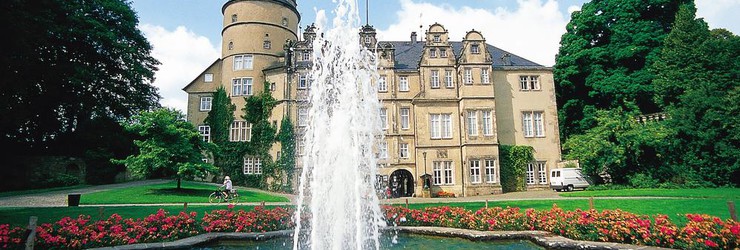The Osnabrücker Land providesmany possibilities
In the automotive museum at the foot of the Melle hills, you can experience 3,000 m² of “History on Wheels” spread over three floors in the listed hall of an old furniture factory. Some 200 first-class, roadworthy vehicles from various eras, from the beginnings of automobiles through to the special exhibits of more recent times and those with a historic significance are presented to the visitor as constantly-changing loan items.
“Bifurcation“ is the process by which a river divides into two branches so that its water flows out into two different river systems – one of the world’s rare phenomena. The Hase river bifurcate in Melle-Gesmold. One part, bearing this name, flows northwest and narrower branch, called Else, flows away in an eastward direction. Take a journey of discovery in the Hase-Else lowland!
Back in 1921, footprints belonging to dinosaurs 150 million years ago were discovered in a quarry in the Wiehen hills near Barkhausen. Today, the quarry is an experience area that provides information on the life of the giant lizards. With replica dinosaur, detailed information boards and a signed, 16 km long dinosaur path. For dinosaur fans, of course, an experience to observe the giant footsteps on the now steeply rising stone wall.
Famous architect Daniel Libeskind designed this house as a museum without an exit. Germany’s Chancellor Gerhard Schröder opened it in 1998 as Libeskind’s first complete work. The US news magazine “Time” ranked it among the Top Ten for contemporary architecture and musical composer Andrew Lloyd Webber praised the museum in front of millions on Germany’s “Wetten dass…?” television programme for its pictures of the Osnabrück artist Felix Nussbaum who was murdered in Ausschwitz. The Felix Nussbaum House – both museum and reminder of the holocaust.
A disused quarry has been home to the Melle Waldbühne for over 50 years. Every Sunday at 3.30 p.m. between May and August each year, the amateur ensemble presents a play for children and every Saturday at 8.00 p.m. in July and August a play for adults. From mid-November onwards, the “Winter’s Tale” is performed every Saturday and Sunday afternoon at 3.30 p.m. in the municipal hall.
Housed in a former quarry for over 50 years home to the forest stage Melle. The amateur theater ensemble performs in the months of May to August every Sunday afternoon at 3.30 p.m. a play for children and in the months of July and August, every Saturday night at 8 p.m. a play for adults. In winter, the performances of the Winter's fairy Tale are from mid-November, every Saturday and Sunday afternoon at 3.30 p.m. in the town hall.
For centuries, the wealthy bourgeoisie built imposing dwellings to show off their affluences and protect themselves from attack. Many of these palaces, castles and eagles nest have been maintained. Admire buildings from many different eras. The baroque palace Iburg, the moated castle Schelenburg from the renaissance period or the New Barenaue palace from the new romantic era - to name but a few. Many palaces are still habited and can therefore only be viewed from outside, some even offer guided tours. The garden festivals at Ippenburg palace are particularly famous.
Its imposing façade is adored by statues of German emperors including Barbarossa and Friedrick II. Inside, there are 42 oil paintings and a priceless charter documenting an important event in European history: the Westphalian peace agreement of 1648, which ended the 30-year war. The terse door knob with the dove of peace on the city hall door points from the past into the future.
A permanent exhibition provides an insight into the life, work and worldwide influence of the in Osnabrück- born writer. The Remarque archive holds the world’s largest collection of materials by and about Remarque.
The site of the Varus battle, a 16th century myth, has been discovered: since late 1989, archaeological research has unearthed more than 6,000 records in the small town on Kalkriese bei Bramsche, north of Osnabrück. These prove that a roman army carrying baggage and equipment were beaten to death at the north face of Kalkriese hill. An exhibition in the multi award-winning museum building uses modern media to present history and research results. The 24 hectare park links the events of the past with those of the present.
One of the most beautiful historical buildings, which, with its gastronomic infrastructure, is available for complete use, is located in the Bad Oeyenhausen public and thermal baths. Visit the former spa hotel to be surprised and enchanted in the GOP-Varieté by international, world class artists in a two-monthly alternating programme.
Come cheek to jowl with the history. This museum explains the long history of textile production. From the past world of cloth maker through to today’s textile industry. Experience the world of fabric in a listed building dating back to the 18th and 19th Century.
Bielefeld’s emblem – Sparren Castle – appears impressively on Sparren hill high above the town. The powerful fortress is situated on one of Germany’s most beautiful hiking trails, the 156 km long Hermannsweg. Built in the middle of the 13th century by Count Ravensberg, the castle was used as an administrative building and dwelling for the local gentry, securing both the town and the trading route in the Bielefeld pass. You can visit the impressive 300 m long underground passage from April to October.
Built on an artificial mound in 1870, the Westhoyel windmill was powered by wind until 1920 and by various engines thereafter. Between 1985 and 1990 the mill was restored and put back into operation. One of the mill’s miller houses was restored in 1993 and the baker’s oven house in 1996. On the milling and baking day held on 4th Sunday of the month between April and September, visitors can follow the journey from corn to flour and then to bread and cake and enjoy the “results” with a cup of coffee.
